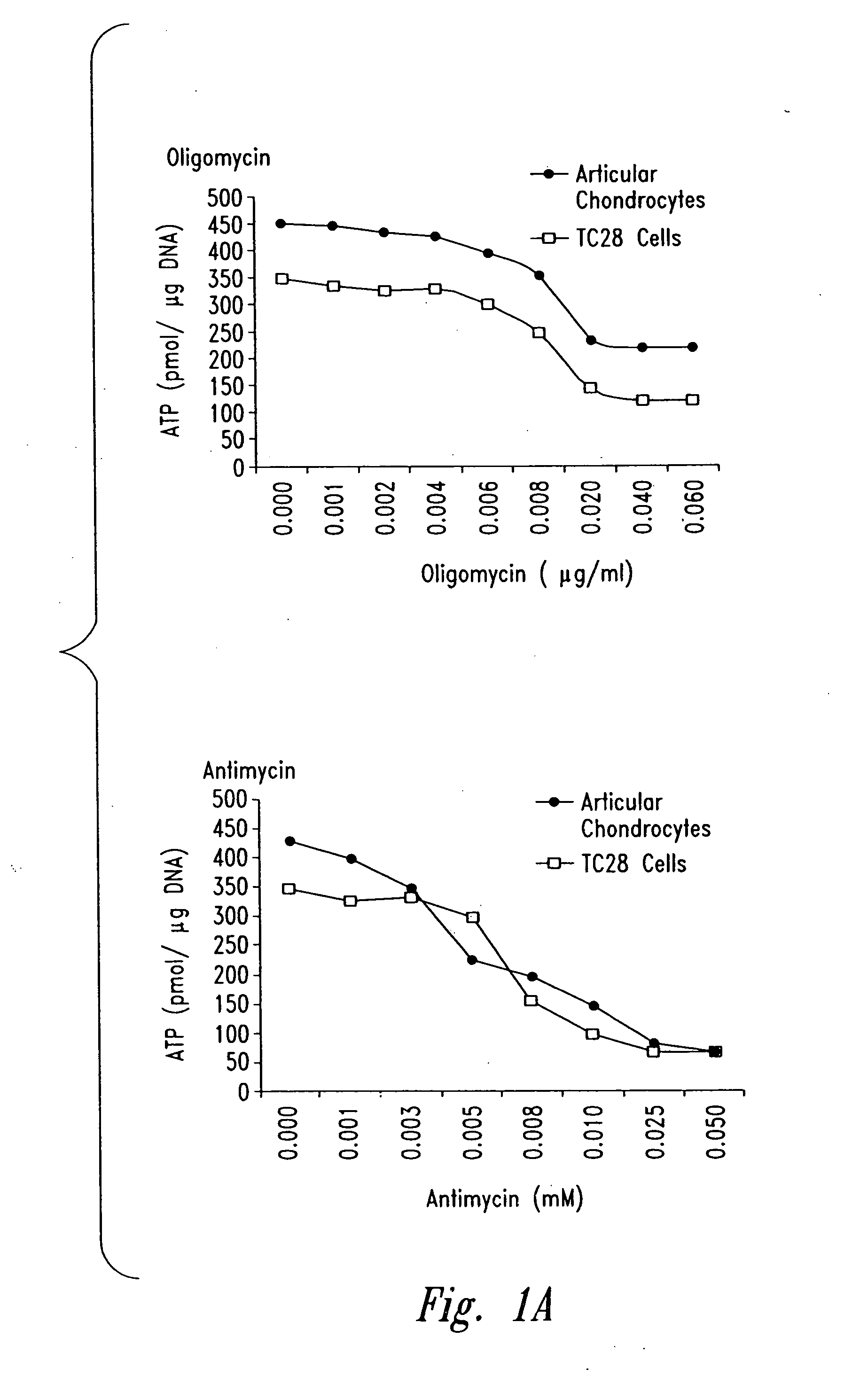Methods and compositions for diagnosing and treating arthritic disorders and regulating bone mass
a technology for arthritic disorders and compositions, applied in the field of arthritis and related disorders, can solve the problems of impaired joint function, reduced mobility of individuals, and reduced mobility of individuals, and achieves the effect of enhancing mitochondrial function
- Summary
- Abstract
- Description
- Claims
- Application Information
AI Technical Summary
Benefits of technology
Problems solved by technology
Method used
Image
Examples
example 1
Inhibitors of Electron Transport Complex III Inhibit Collagen and Proteoglycan Synthesis in Chondrocytes
[0196] In order to determine if inhibition of mitochondrial function (specifically, inhibition of electron transport chain complex III) impacts collagen and proteoglycan synthesis by chondrocytes, the following experiments were carried out.
[0197] Human articular cartilage chondrocytes were obtained by collagenase digestion of articular cartilage samples, and subsequent monolayer culture, essentially as described by Terkeltaub et al. (Arthritis Rheum. 41:2152-2164, 1998). The starting material for these primary cultures was human articular cartilage excised during surgical joint replacement, or obtained at autopsy from normal or osteoarthritic joints. The articular chondrocytes were grown in Dulbecco's modified Eagle's Medium with high glucose (DMEM high glucose, Life Technologies, Inc. Grand Island, N.Y.) with 10% fetal calf serum (FCS), 1% glutamine, 100 U / ml penicillin and 50 ...
example 2
Inhibitors of Electron Transport Complex V Inhibit Collagen And Proteoglycan Synthesis in Chondrocytes
[0206] In order to confirm that inhibition of mitochondrial function generally impacted collagen and proteoglycan synthesis by chondrocytes, as contrasted with a mechanism by which antimycin A specifically or directly depressed these functions, the following experiments were carried out with oligomycin, which acts to inhibit the electron transport chain at a different target (complex V) than antimycin A (complex III).
[0207] Chondrocytes were prepared and cultured as in the previous Example and treated with progressively higher concentrations of oligomycin (all reagents in these Examples were from Sigma, St. Louis, Mo., unless otherwise noted). Mitochondrial and cellular functions were assayed in order to determine a level of oligomycin that met the same criteria as those established in the preceding Example for antimycin A (i.e., that depressed total cellular ATP levels without ca...
example 3
Inhibitors of Electron Transport Block the Ability of Tgfβ to Stimulate Chondrocyte Functions
[0210] Transforming growth factor beta (TGFβ) is characterized by its potent and widespread actions, which may be used to distinguish it from a number of other known growth factors (for a review, see, e.g., Clark et al., Int. J. Biochem. Cell. Biol. 30:293-298, 1998; Alevizopoulos et al., Bioessays 19:581-591, 1997; and Massagu, Annu. Rev. Biochem. 67:753-791, 1998). It has been suggested that TGFβ plays an important role in the repair potentiality of joint cartilage, especially in arthritis (Pujol et al., Ann. Endocrinol. 55:109-120, 1994). High concentrations of TGFβ have been found in synovial fluid from arthritic joints (van Beuningen et al., Lab. Invest. 71:279-290, 1994). TGFβ stimulates synthesis of extracellular matrix components such as collagen, fibronectin and proteoglycan (Roberts et al., Kidney Intl. 41:557-559, 1992), and suppresses proteoglycan degradation in vitro. Moreover,...
PUM
| Property | Measurement | Unit |
|---|---|---|
| diameter | aaaaa | aaaaa |
| molecular weights | aaaaa | aaaaa |
| electrochemical potential | aaaaa | aaaaa |
Abstract
Description
Claims
Application Information
 Login to View More
Login to View More - R&D
- Intellectual Property
- Life Sciences
- Materials
- Tech Scout
- Unparalleled Data Quality
- Higher Quality Content
- 60% Fewer Hallucinations
Browse by: Latest US Patents, China's latest patents, Technical Efficacy Thesaurus, Application Domain, Technology Topic, Popular Technical Reports.
© 2025 PatSnap. All rights reserved.Legal|Privacy policy|Modern Slavery Act Transparency Statement|Sitemap|About US| Contact US: help@patsnap.com



